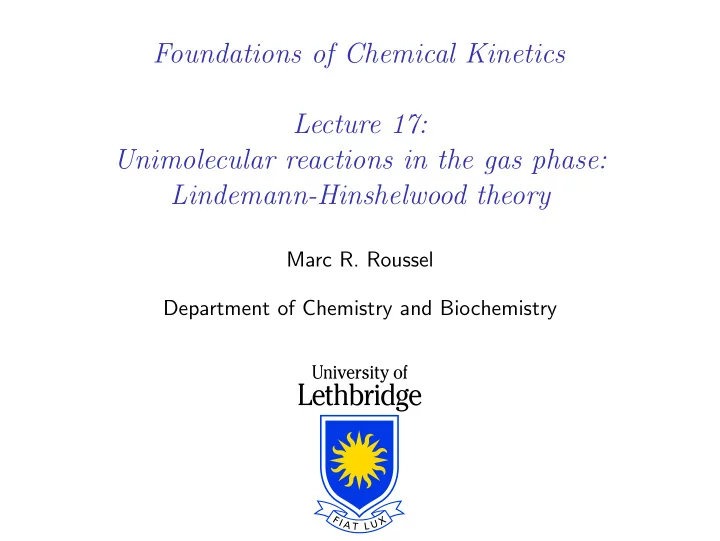

Foundations of Chemical Kinetics Lecture 17: Unimolecular reactions in the gas phase: Lindemann-Hinshelwood theory Marc R. Roussel Department of Chemistry and Biochemistry
The factorial ◮ The number n ( n − 1)( n − 2) . . . 1 is called the factorial of n . Notation: n ! (read “ n factorial”) ◮ By convention, 0! = 1.
Marc’s notation vs the textbook’s ◮ Albert Goldbeter once told me that you knew that a student was taking ownership of their project when they wanted to change the notation. . . Quantity Textbook Marc Sum (number) of states G G Density of states N g
Density of states for s harmonic oscillators ◮ In lecture 6, we derived the following expressions for the sum and density of states of a harmonic oscillator: G ( ǫ ) = ǫ ( � ω 0 ) − 1 g ( ǫ ) = ( � ω 0 ) − 1 ◮ Recall: Roughly speaking, the partition function counts the number of states with energies below k B T . Therefore, Q ≈ k B T � ω 0 Note: You can also derive this equation from the harmonic oscillator partition function by assuming that � ω 0 / k B T is small, as we did in lecture 12.
Density of states for s harmonic oscillators (continued) ◮ If we have s distinguishable, independent harmonic oscillators whose natural frequencies are ω i , the partition function should therefore be s k B T � Q s ≈ � ω i i =1 ◮ From the definition of the classical partition function, we have � ∞ � − E � Q s = g s ( E ) exp dE k B T 0
Density of states for s harmonic oscillators (continued) � ∞ s � � − E k B T � Q s = g s ( E ) exp dE ≈ k B T � ω i 0 i =1 ◮ The problem now is to find the density of states corresponding to our partition function Q s . This problem turns out to be solved by taking a mathematical operation called an inverse Laplace transform of Q s . The answer is E s − 1 g s ( E ) = ( s − 1)! � s i =1 � ω i
Hinshelwood theory ◮ Recall that a collision-theory treatment badly underestimates the Lindemann rate constant k 1 . ◮ Hinshelwood’s idea was that the energy acquired in a collision can be stored in any of the bonds in a molecule, and that this therefore introduces a statistical factor (the degeneracy of the corresponding total vibrational energy) into the calculation of the rate constant. ◮ A classical treatment, assuming that the temperature is sufficiently high that we can treat the vibrational levels as continuous, will use the density of states rather than the degeneracy.
Hinshelwood theory (continued) ◮ For simplicity, Hinshelwood assumed that the s vibrational modes of a molecule had a common vibrational frequency ω 0 . Then, � s � k B T Q s ≈ � ω 0 E s − 1 g s ( E ) ≈ ( s − 1)! ( � ω 0 ) s ◮ The probability that a molecule has vibrational energy between E and E + dE is thus E s − 1 g s ( E ) � − E � � − E � exp dE = ( k B T ) s ( s − 1)! exp dE Q s k B T k B T
Hinshelwood theory (continued) ◮ The probability that a molecule has energy greater than E a is therefore � ∞ E s − 1 � � − E ( k B T ) s ( s − 1)! exp dE k B T E a ◮ This integral gives Γ( s , E a / k B T ) / ( s − 1)!, where Γ() is the incomplete gamma function. ◮ Typically, E a ≫ k B T . In this case, the integral is well approximated by � E a � s − 1 1 � − E a � exp ( s − 1)! k B T k B T
Hinshelwood theory (continued) ◮ Assuming a collision-limited rate, the rate constant k 1 is therefore � E a � s − 1 A ct � − E a � k 1 = A ct Pr( E > E a ) = exp ( s − 1)! k B T k B T ◮ Since E a / k B T ≫ 1, � E a � s − 1 1 ≫ 1 , ( s − 1)! k B T which explains why collision theory fails so badly for some unimolecular reactions.
Hinshelwood theory Summary and comparison to experiment ◮ Explains why k 1 is larger than the collision-limited value: the vibrational degeneracy allows molecules to store the same amount of energy in many different ways, introducing a statistical factor into the theory. ◮ We assume s oscillators with equal vibrational frequencies. In practice, we treat s as a parameter which we choose to get the best fit to the data. Typically we find that s is about half of the normal modes of the reactant. ◮ Hinshelwood theory fits the pressure dependence of the observed rate constant better than plain Lindemann theory. However, there are still deviations at low pressures. ◮ Because of the strongly T -dependent preexponential factor, Arrhenius plots for k 1 (or k ∞ ) should be curved. They are not.
Recommend
More recommend